

Tourists take a picture during a stop on the scenic M-54 highway - basically the only road that connects Tuva with the rest of Russia. The rugged Yergak-Targak-Taiga ridge - part of Sayan Mountains - is visible in the background. Tuva lies behind this ridge.
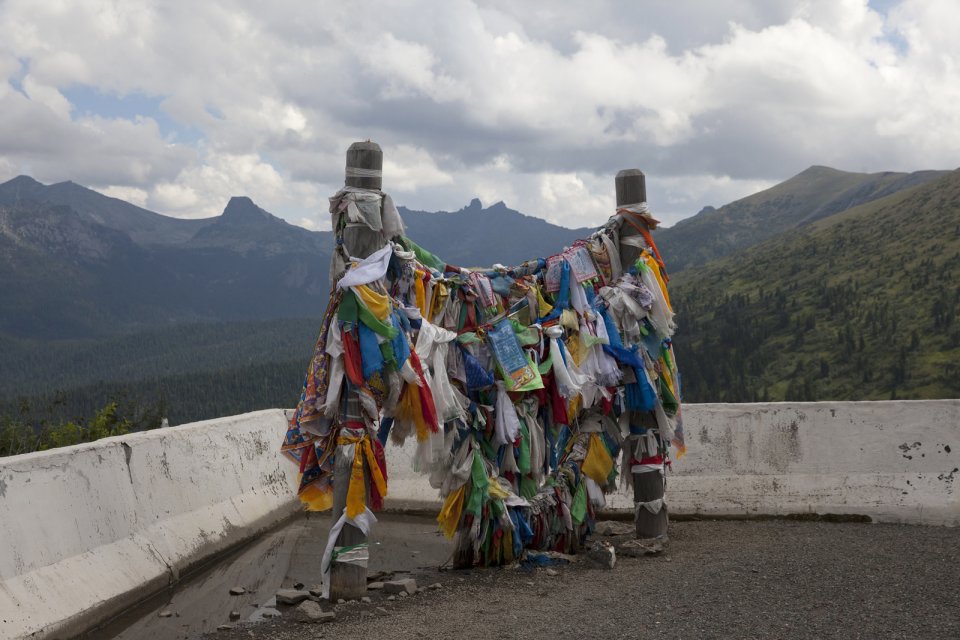
An ovaa - a traditional sanctuary made of Buddhist prayer ribbons and blessing scarves - at Buibinsky Pass on the scenic M-54 - basically the only road that connects Tuva with the rest of Russia. The Yergak-Targak-Taiga ridge visible in the background forms Tuva's natural boundary.

Tourists take a picture near The Shelf - an anti-avalanche tunnel on the scenic M-54 highway in the Sayan Mountains. The M-54 is basically the only road connecting Tuva with the rest of Russia.

Entrance sign that reads "Republic of Tuva" in Russian and depicts a Chinese-styled dragon and the region's seal - a yellow horseman; to the left is an ovaa - a traditional sanctuary made of poles with Buddhist prayer ribbons and blessing scarves attached. From 18th century up until 1912, Tuva was part of the Chinese Qing Empire, and the Chinese cultural influence, although largely forgotten, can sometimes spring up in new landmarks such as this one.
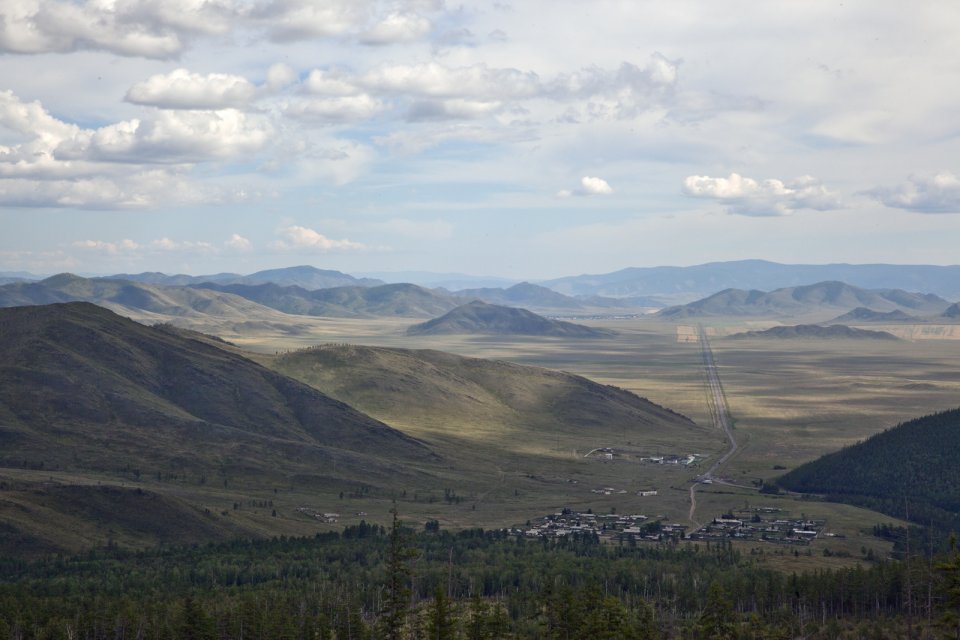
The Turano-Uyuk depression dubbed the Valley of Kings after a burial of a 7-century-BC Scythian "king" with thousands of golden objects and other paraphernalia was discovered here in 2002 by a Russian-German archaeological expedition. The M-54 highway that connects Tuva with the rest of Russia is visible on the right.

A street scene in downtown Kyzyl, the capital of Tuva, with a campaign poster depicting the Tuvan governor Sholban Kara-Öol. Mr Kara-Öol, a trained political scientist, was first appointed governor of Tuva by president Putin in 2007 and confirmed for a second term in 2016.

Kids playing with the Buddhist prayer wheel in the Tuvan capital Kyzyl's main square. After the breakup of the Soviet Union, Buddhism has seen a controversial revival in Tuva, marred by expulsion of popular foreign preachers and tight control on the part of the government.

A father and his kids visit the "first" rail track section and a foundation stone outside the Tuvan capital Kyzyl where its future railway station is supposed to sit. Tuva has never had any railways. A rail link that would connect Tuva with the southern branch of the Transsiberian Railway has been designed and approved by the Russian government in 2007 but the project has never taken off ever since due to doubts about its cost-effectiveness.

Choiganmaa, a journalist, and Shoraan Kuular, a stock farmer, celebrate their wedding with friends at a symbolic gateway to Tuva outside the capital Kyzyl where its future railway station is supposed to sit. Tuva was a vassal of the Chinese Qing Empire until 1912 and the Chinese influence, although largely forgotten, can still sometimes spring up in new landmarks such as this one.

A Buddhist stupa in Kaa-Khem, a suburb of Kyzyl. After Tuva has formally joined the Soviet Union in 1944, all monks were arrested and temples completely destroyed to help Communist ideology take hold instead. After the breakup of the Soviet Union, Buddhism has seen a controversial revival in Tuva, marred by expulsions of popular foreign preachers and tight control on the part of the government.

Eastern outskirts of the Tuvan capital Kyzyl with a Soviet-era unfinished power station towering over it. Lack of power generation capacity causes frequent power outages both in the capital and rural areas. Of Russia's 83 regions, Tuva is the worst economic performer largely relying on federal subsidies.

Tuvan capital Kyzyl's eastern suburb Kaa-Khem. The city grew significantly after the collapse of the Soviet economy when thousands of rural residents of Tuva came to Kyzyl in search of jobs, settling, often illegally, on empty lands on the city's outskirts.

Young residents of Kyzyl hang out outside of the Soviet-built National Theater in the Tuvan capital Kyzyl.

Farmers build a yurt for the annual festival Naadym (pronounced Nah-Dim) in Tos Bulak. The festival is an important element of today's Tuvan identity and includes various competitions such as the Best Yurt, horse racing, arching, wrestling and cooking contests. During Soviet era, Naadym as well as other Tuvan traditions were largely banned.

Farmers prepare for the annual stock farmers' festival Naadym (pronounced Nah-Dim) in Tos Bulak. The festival is an important element of today's Tuvan identity and includes various competitions such as Best Yurt, horse racing, arching, wrestling and cooking contests. During Soviet era, Naadym as well as other Tuvan traditions were largely banned.

Saidash Kol, 28, a deer farmer and hunter from Todzha (a remote and hard-to-get area in northeastern Tuva), poses for picture in his tent he and his workers have built for the yearly stock farmers' festival Naadym in Tos Bulak. He also owns a fishery, a cafe and a hotel in his village. Once nomadic deer farmers, Todzha Tuvans no longer live in this kind of tents, preferring village homes, but some still know how to build a tent for special occasions such as Naadym.

Deer farmers from Todzha (a remote and hard-to-get area in northeastern Tuva) built these traditional tents for the annual Naadym stock farmers' festival (pronounced Nah-Dim) in Tos Bulak. Once nomadic deer farmers, most Todzha Tuvans no longer live in such tents, preferring village homes, but some still know how to build a tent for special occasions such as Naadym. Deer were not brought over because they pasture deep in the forest during this time of year and their respiratory systems are not used to dusty steppes.

A horse tied to an off-road vehicle before the annual Naadym horse race. Owning horses is considered a matter of prestige and status by many Tuvans, and the Naadym race requires a lot of money and effort but rarely pays off.

Brothers Salgyn, 14, and Kheimer, 13, Dongak prepare for the annual 15-km horse race as part of Naadym farmers' festival. Both Salgyn and Kheimer have been jockeys since the age of 8. Race rules allow neither saddles nor helmets. "If we wore them, we would be laughed at", the brothers said.
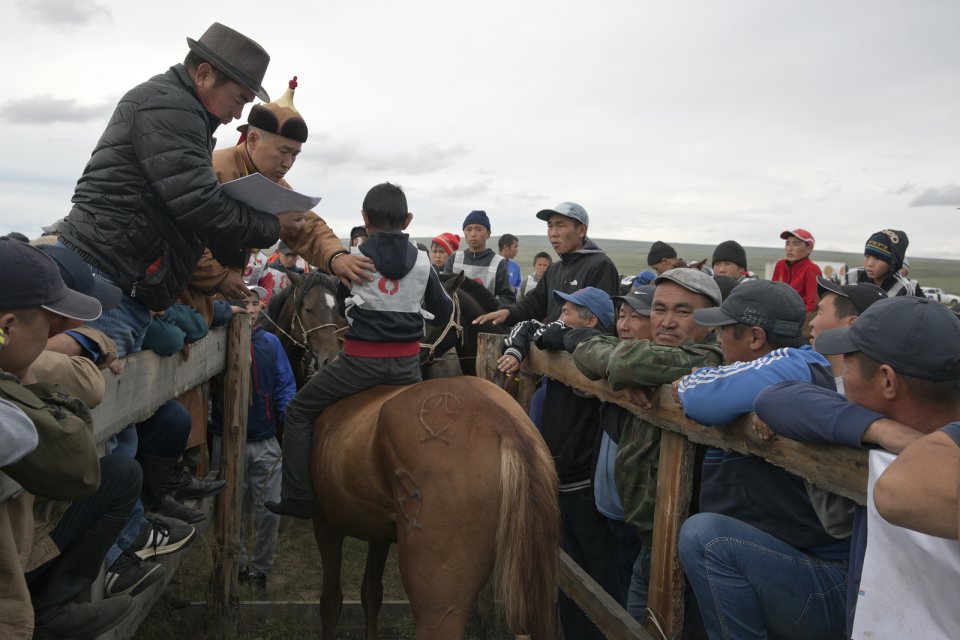
A horse has just been disqualified from racing in the annual Naadym race - only horses 4 y.o. and younger were allowed to race. The age is defined by inspecting the horse's teeth: those older than 4 years old have molars grown up.

Start of the 15-km horse race as part of the annual farmers' festival Naadym. Rules allow neither saddles nor helmets. Boys can become jockeys since the age of 6.
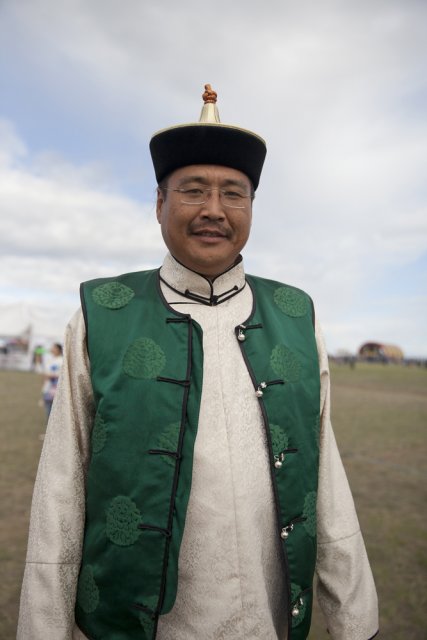
Igor Koshkendey, a prominent Tuvan throat singer and musician, attends the annual farmers' festival Naadym as part of the Best Yurt contest jury.

Inside a "model" yurt participating in the Best Yurt contest as part of the annual farmers' festival Naadym; portraits are those of Russian president Vladimir Putin, Tuvan governor Sholban Kara-Öol, Russian defense minister and a native of Tuva Sergei Shoigu, and Dalai-Lama. This yurt eventually won the contest.

Oleg Khertek, head of Tuva's Erzin district bordering Mongolia, with his deputy Bayirma Izhigin, attending the annual farmers' festival Naadym - a rare occasion to wear their folk costumes.

An obelisk by artist Dashi Namdakov marking what is believed to be the geographical center of the Asian continent. Why exactly was this place chosen as such is unknown but a Russian engineer who authored a 1910 book about Tuva mentioned an English traveler who had come to the area willing to see the "center of Asia". The confluence of Kaa-Khem and Piy-Khem rivers forming Yenissei - Russia's longest river - is visible in the background.

Nikolay Öorzhak, a shaman, in his Kyzyl office. Trained as a stage designer in Moscow, he later served as art director of the Tuvan National Theater in Kyzyl. In 1990, he founded Tuva's first community of shamans. "You can understand shamanism only if you become a shaman yourself. Shamanism is not a religion", he says, "it is a foundation of all religions. God is the energy of the universe, all else - Buddha, Christ - are just images". Mr Öorzhak says he receives many Western visitors, mostly psychologists, and has traveled extensively around the world.

Khuresh - a traditional wrestling competition - is held as part of the annual farmers' festival Naadym. An assistant referee holds the wrestlers' caps as a sign of respect. The aim of the fight is to wrestle one's rival down to the grass.

Tuva deputy governor Anatoly Damba-Khuurak (center, in white) posing for picture with Russian and Mongolian sports officials (in folk costumes) and this year's khuresh wrestling champions (above)

This market in Kyzyl still looks like such places looked all over Russia in early 1990s when market reforms began.

A roadside cafe in Balgazyn on the M-54 road half way between Tuvan capital Kyzyl and the Mongolian border.

A gate on the M-54 highway marking the entrance to Erzin Kozhuun - a district in southeastern Tuva bordering Mongolia. Tuva is one of only two Russian regions (the other being Sakha-Yakutia) where administrative subdivisions are named in a local language (otherwise it's always rayons in Russian). The Tuvan word kozhuun that denotes a district traces back to the old Mongolian term khoshun of the same meaning (still in use in China's Inner Mongolia), testifying to the long period of Mongolian/Chinese domination in Tuva.

Inside Buddhist sanctuary Sunrap Gyatsoling in Erzin near Mongolian border.

Iraida Baldyr, a retied nursery teacher, now serving as housekeeper at Buddhist sanctuary Sunrap Gyatsoling in Erzin near the Mongolian border.
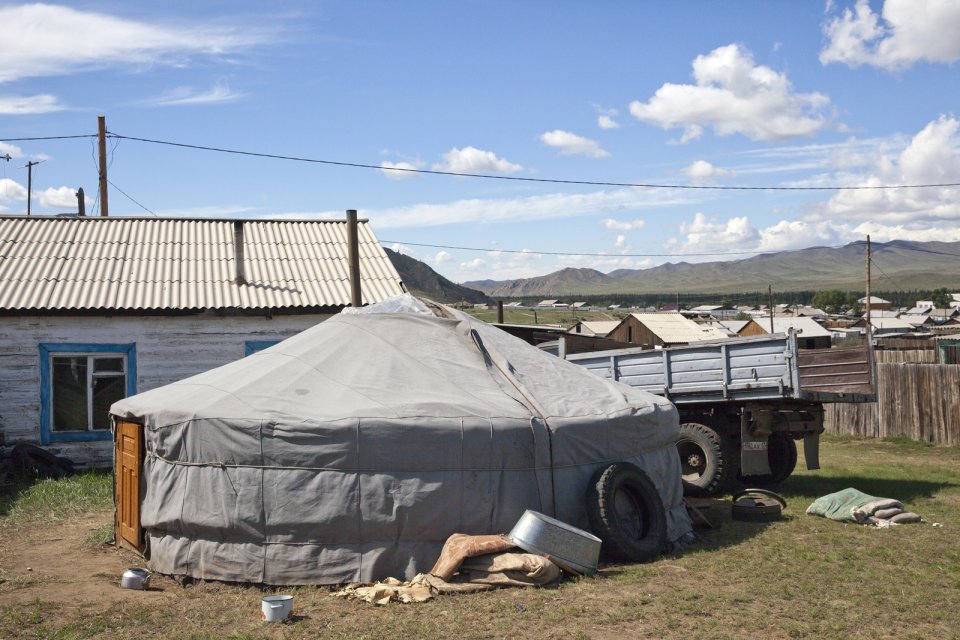
Bandan family home and a yurt in Naryn, southeastern Tuva. In summer, two generations of the Bandan family live in two yurts in the Kachyk river valley, some 100 km east of Naryn, from fall to spring the younger part returns to Naryn in order for the kids to attend school.

Members of the Bandan family take a rest on the way to their nomadic station.

Ertine Bandan (on the roof of the vehicle) unloads the luggage near the home of Bayir-Kys Banchyk - director of the village hall (in red sleeveless jacket) whom he gave a ride - in front of her home in Kachyk, a remote and hard-to-get village near the Mongolian border. The isolated Kachyk community has about 300 residents, partly living in the village itself, partly - at nomadic stations in the surrounding valleys. According to Moscow-based sociologist Artemiy Pozanenko who has been studying spacially isolated communities in the post-Soviet world, they tend to be more cohesive and self-sustainable because in part of unlimited access to natural resources around them and absence of regulatory authorities.

Kachyk, a remote and hard-to-get village near the Mongolian border. The building with the antenna on the right is the village's elementary school. The isolated Kachyk community has about 300 residents, partly living in the village itself, partly - at nomadic stations in the surrounding valleys. There's no police, no doctors, no shops in the village. Electricity is produced by a portable generator and is only available when it's dark. According to Moscow-based sociologist Artemiy Pozanenko who has been studying spacially isolated communities in the post-Soviet world, they tend to be more cohesive and self-sustainable because in part of unlimited access to natural resources around them and absence of regulatory authorities. A school is the only institution in these communities thanks to which they continue to exist. In late 1960s, all residents of Kachyk have been airlifted by the Soviet authorities of Tuva to the nearest bigger village Naryn, about 100 km away, because of poor acess but after the breakup of the Soviet Union many of them returned to their ancestral homes.

Bayir-Kys Banchyk gets her cows and bulls into her courtyard after they returned from summer pastures. Mrs Banchyk, 40, a mother of three and native of this remote Kachyk area in southeastern Tuva bordering Mongolia, holds a well-paying government job of director of the village hall and has about 180 of own cows, several horses, and yaks. After the breakup of the Soviet Union citizens were allowed to raise stock of their own, and many Tuvans who had earlier been forced to abandon their thousand-year-old stock farming practices by the Soviet regime are gradually returning to the lifestyles of their stock farming ancestors.

Villagers and members of Bandan family unload their truck at a community warehouse in Kachyk - an isolated village in southeastern Tuva bordering Mongolia - after returning from the yearly stock farmers' festival Naadym. This community won the Best Yurt competition and because they prepared and made that yurt together, the prize - 90,000 RUB (ca. $1,400) - will be shared according to everyone's contribution.

Shimitsi Khumbun, 79 (center, in red, with granddaughter Sanchira on her knees) was born and has been living in the Kachyk river valley for her entire life, she has 16 children (of which two live next to her to help her and are present in the picture - Robert to her left and Maya to her right), about 90 grandchildren and 19 great grandchildren. Standing from left to right Mrs Khumbun's grandchildren Angarmaa, Buyana, Gazhidmaa, Sanchay, and Nachyn.

A yurt owned by Bandan family in the remote and hard-to-get Kachyk area in southeastern Tuva; a solar panel is visible on the roof.

Alimaa and Ertine Bandan, 28 and 29, with their sons Bimdorch, 9, and Sayin-Belek, 3, posing for picture in their family yurt. In summer, they live in this yurt in the Kachyk river valley - a remote area in southeastern Tuva bordering Mongolia. In fall, they return to the nearest big village Naryn - some 100 km away - where they also have a house and where Sayim-Belek goes to school. Together with Ertine's parents and other relatives, the Bandan family keeps more than 2,000 stock - mostly sheep, cows and horses. They have about 80 hectares of private land and rent more land for a winter station. Alimaa also makes traditional Tuvan skin and wool clothes mostly for family use. Says Ertine: "I like it more when we are here in the valley, living in our yurt, I am my own boss here, there is no authority above. We all know each other here and live together peacefully".

There are often two yurts at a nomadic station, meaning there are two generations of one family living one next to the other. Kachyk river valley, southeastern Tuva.

Bayir-Kys Banchyk with one of her yaks Masha. Mrs Banchyk, 40, a mother of three and native of this remote Kachyk area in southeastern Tuva bordering Mongolia, holds a well-paying government job of director of the village hall and has about 180 of own cows, several horses, and yaks. After the breakup of the Soviet Union citizens were allowed to raise stock of their own, and many Tuvans who had earlier been forced to abandon their thousand-year-old stock farming practices by the Soviet regime are gradually returning to the lifestyles of their stock farming ancestors.

Boris Sodunam or simply Sodunam-Bashki (Sodunam the Teacher), 70, founded the first official Buddhist community in Tuva when religious freedoms were granted in the Soviet Union in 1990. He then became a hermit and has been living in seclusion for the last 20 years in this remote Sutluk river valley - his homeland in southeastern Tuva. Over this period, he has built a small monastery which consists of a temple, a house and a small hostel for disciples and visitors whom he receives in considerable numbers, including high-ranking Russian officials, such as a police general whose portrait he is posing for picture with. Because he knows the governor personally, he also acts as an informal representative for the local community.

Boris Sodunam or simply Sodunam-Bashki (Sodunam the Teacher), 70, founded the first official Buddhist community in Tuva when religious freedoms were granted in the Soviet Union in 1990. He then became a hermit and has been living in seclusion for the last 20 years in this remote Sutluk river valley - his homeland in southeastern Tuva. Over this period, he has built a small monastery which consists of a temple, a house and a small hostel for disciples and visitors.
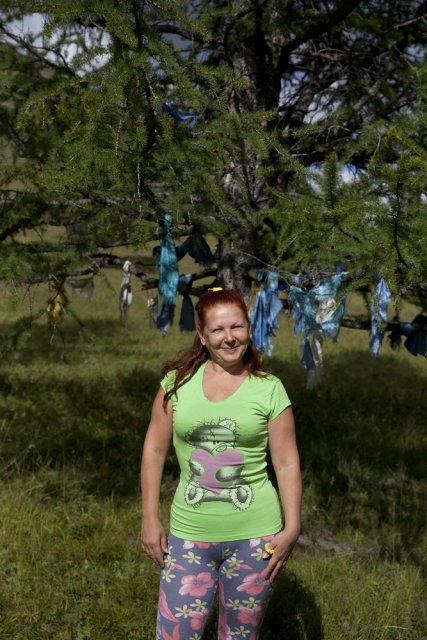
Svetlana Lugovaya, a Moscow-based psychic, has been visiting the Sutluk river valley - a remote area in southeastern Tuva - for 8 years now. She stays here with her husband next to her teacher - Sodunam-Bashki - a Buddhist hermit.

Bayir-Kys Banchyk and Valentina Sambyr demonstrate the traditional way to tan cowhide which is then used to make shoes, as youngsters look on. Such crafts survive only in such isolated communities as this one in Kachyk river valley in southeastern Tuva.

Valentina Kenden milking a yak in the Kachyk river valley - a remote area in southeastern Tuva bordering Mongolia. Mrs Kenden normally lives in Erzin - the district center - where she works as a nurse but on vacation she comes back to her family yurt and helps her parents and brother with their cattle - sheep, cows and yaks.
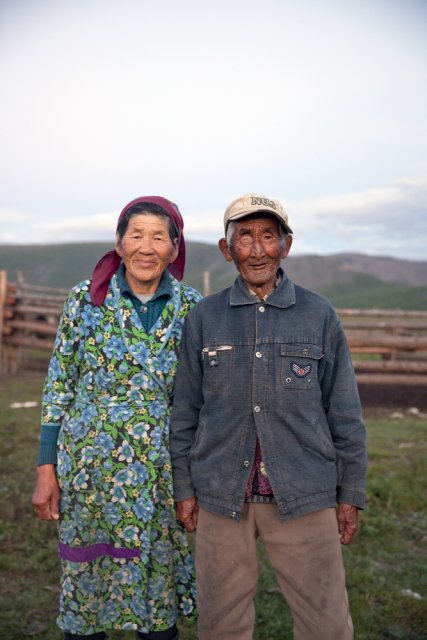
Nyura Bary-Khoo, 70, and Balchyn Kenden, 78, have been making a living as nomadic shepherds for their entire life. Mrs Bary-Khoo served as member of parliament of Soviet Tuva from 1975 to 1980 but then returned to her home area - the remote Kachyk river vallery in southeastern Tuva bordering Mongolia.

An ovaa - a sacred place - at Balik Kharaar on the left bank of the Yenissei river

Filipp (41) and Shonchalay (37) Kozenyuk with their daughter Daria pose for picture in front of their house in central Kyzyl - the Tuvan capital. More than a 100 years since Tuva first became a Russian protectorate and even more years since first Russian settlers began penetrating in the isolated Tuva, mixed marriages are still a rare sight here. Filipp was born in Hungary, the son of a Soviet army officer. Trained as a psychologist in Moscow, he worked as a chef at a Japanese restaurant in the Russian capital where he met Shonchalay, a native of a Tuvan village who failed her exams at a Moscow university but stayed on and went to work as a waitress at that Japanese restaurant (in early 2000s, these establishments hired mostly 'Asian-looking' Russian minorities including Tuvans, Kalmyks, Buryats and Yakuts).

Soviet-era built environment in central Kyzyl - the Tuvan capital. Founded in 1914 as Belotsarsk (Russian for "City of the White Tsar"), the city became capital of the independent Tuva and was renamed Khem-Beldir (the Confluence) in 1921 as it sits at the confluence of two rivers that form one of the longest rivers in the world - the Yenissei. Under the influence of Communist Russa, the Tuvan government has again renamed the city in 1926. Kyzyl is Tuvan for "Red". The population rose significantly from 87,000 in 1991 to 116,000 in 2016 due in part to migration of rural Tuvans to town after the collapse of the Soviet collective farms in the countryside. Over the last 25 years however, there has not been a single block of flats built in Kyzyl, its infrastructure is gradually dilapidating, and new arrivals mostly settle in illegally built slums on the outskirts. Of Russia's 83 regions, Tuva is the worst economic performer mostly relying on federal subsidies.

A lookout at an ovaa - a sacred place at Balik Kharaar on the left bank of the Yenissei river

Chechekmaa Ishina, 53, poses for picture in front of an altar in the house in Chadan she has built on her own savings for her teacher - Tibetan monk Shivalkha Rinpoche. Reverend Rinpoche has lived in Tuva for 7 years and has become very popular among Tuvan Buddhists until he was deported at the order of the Federal Security Service in 2015.

A museum in Chadan dedicated to the current Russian defense minister Sergei Shoigu. It opened in 2015 in his former family house. Born in Chadan in 1955 into a family of an animal technician Alexandra Kudryavtseva who was sent to Tuva from Russia to help upgrade local stock breeding and later became a prominent local Communist official and a local newspaper editor and also a Communist official Kuzhuget Shoigu, Mr Shoigu rose to prominence in early 1990s and has held various top ranking posts in the Russian government ever since. Since he became a defense minister in 2012, a local cult of Mr Shoigu's personality has developed in Tuva, and especially in his hometown Chadan.
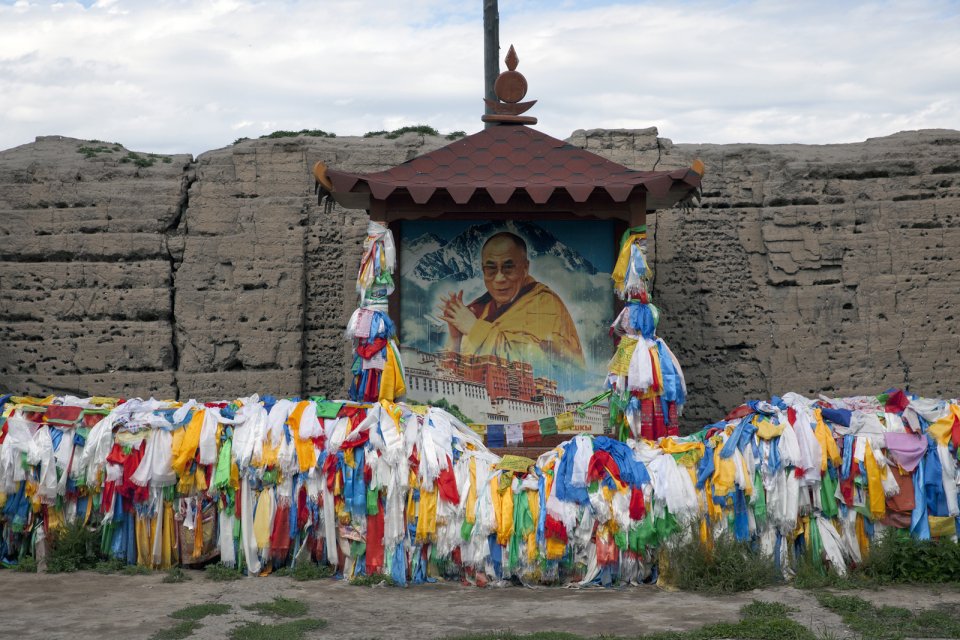
A portrait of Dalai Lama with prayer ribbons and blessing scarves at what remains from a 1908 Buddhist sanctuary Ustuu-Khure outside Chadan in western Tuva, which at the time of its completion was an important center of the Tuvan nation-building: the first Tuvan alphabet was developed here and the first coin minted. The monastery was built at the order of the local noyon (tribal ruler) Khaidyp - the adoptive father of the future founder and first prime minister of independent Tuva Mongush Buyan-Badirgi. After Buyan-Badirgi was arrested and murdered after a coup staged by his Communist-leaning subordinates, this monastery was destroyed and all monks arrested, some of them executed. The monastery was revived in 2008 with the support of the then Emergencies Minister and a native of Chadan Sergei Shoigu - Russia's current defense minister.

Geshe Dakpa Gyaltsen, 48 - a Tibetan monk visiting Ustuu-Khure - an important Buddhist sanctuary outside Chadan in western Tuva. Reverend Gyaltsen has been living and preaching in Russia since 15 years and has taken up Russian citizenship - a requirement to be able to lead religious communities.

Buddhist sanctuary Dupten Sheduplin near Sug-Aksi in western Tuva, with Alash Plateau visible in the background. After Tuva has formally joined the Soviet Union in 1944, all monks were arrested and temples completely destroyed to help Communist ideology take hold instead. After the breakup of the Soviet Union, Buddhism has seen a controversial revival in Tuva, marred by expulsion of popular foreign preachers and tight control on the part of the government.
![Aimir, a native of Chadan, is a 5-year student at the Moscow Mining University but comes home every summer. After graduation, he wants to join Lunsin - a Chinese mining company operating in Tuva. Asked whether the residents of Chadan are really proud of their famous fellow townsman - current Russian defence minister Sergei Shoigu - he answers after pondering for a second: "Yes, we are proud. When police in Moscow check my papers [a regular thing 'Asian-looking' Russians and Central Asian migrant workers face almost every day] they immediately let me go when they see my home address - Chadan, Sergei Shoigu Street".](/cache/comissions/Tuva/Max_Sher_Voyages_Tuva_Preview_7931_640.jpg)
Aimir, a native of Chadan, is a 5-year student at the Moscow Mining University, coming home every summer. After graduation, he wants to join Lunsin - a Chinese mining company operating in Tuva. Asked whether the residents of Chadan are really proud of their famous fellow townsman - current Russian defence minister Sergei Shoigu - he answers after pondering for a second: "Yes, we are proud. When police in Moscow check my papers [a routine 'Asian-looking' Russians and Central Asian migrants face almost every day] they immediately let me go when they see my home address - Sergei Shoigu Street".

A young shepherd on a horse with his sheep on a road in western Tuva under a heavy rain. After the construction of Sayano-Shushenskaya hydroelectric dam on river Yenissei a few hundred kilometers north in the 1980s, locals have been observing a drastic change in climate which became warmer and more humid, with heavy and abrupt rains.

An unfinished new wing of the National Museum of Tuva; its construction faltered due to lack of funds.

Detail of the first Tuvan flag dating back to 1921 preserved at the National Museum in the capital Kyzyl. Once part of a vast medieval Turkic Khaganate, Tuva became a remote province of Chinese-run Mongolia in 18th century and remained so until 1912. When the Qing Empire collapsed that year, Tuvan tribal leaders appealed to the Russian tsar Nicholas II for protection, and in 1914 a Russian protectorate known as Uriankhai Territory (Uriankhai was a Mongolian term for Tuvans) was established and its capital Belotsarsk (Russian for "City of the White Tsar") founded. When the Russian Empire collapsed in turn just 3 years later, Tuva was left on its own until 1921 when it declared independence but delegated foreign policy to the Soviet government. It was only recognized by neighboring Russia and Mongolia though while all other countries continued to consider it a Chinese territory. Up until 1944 when the People's Republic of Tuva has formally joined the Soviet Union, it was a de facto Soviet protectorate. Interestingly, Taiwan continues to formally consider Tuva part of Greater China. Unusually for an overcentralized Russia, Tuva celebrates its main holiday coinciding with the day of independence (15 August) not the day when it was incorporated into the Soviet Union (11 October).

Konstantin V. Chugunov, an archaeologist with the State Hermitage Museum in St. Petersburg, posing for picture in front of a burial mound being excavated by an expedition he leads in the so-called Valley of Kings in northern Tuva. Mr Chugunov has dedicated almost his entire career to exploring the ancient monuments of Tuva. In 2003, he and Hermann Parzinger of the German Archaeological Institute in Berlin have discovered here a rich burial of a noble Scythian, his wife and guards with thousands of golden and other paraphernalia. The largest part of the discovery is displayed at the National Museum of Tuva in Kyzyl, a smaller part - at The Hermitage Museum in St. Petersburg.

Founded in 1885 when Tuva was still formally part of the Chinese Qing Empire, Turan became the first Russian permanent settlement in Tuva. Russian farmers and merchants began penetrating into the isolated and remote Tuva even earlier, quiclky realizing how immensely profitable the trade in cattle was with the indigenuous Tuvans who bought firearms, tobacco, alcohol, and other industrially made items from them. Unlike most of Russia's territorial gains, Tuva became a Russian protectorate mostly through trade and political influence, without firing a single shot. The blue church visible in the foreground was built in the early 20 century, the new one is being built by a local businessman.